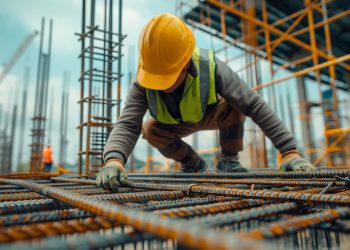The US engineering and construction (E&C) industry began 2020 on a bright note—and then COVID-19 hit. Despite the challenges that have resulted, there are reasons to be optimistic. Deloitte explores five engineering and construction industry trends that will impact the coming year, from connected construction to new business models.
The construction industry added more than $900 billion to the US economy in the first quarter of 2020—its highest level since the 2008 recession. It employed 7.64 million people in February 2020, also the highest levels since 2008. Then, COVID-19 reached the United States, causing the industry to lose $60.9 billion in GDP and decreasing total jobs to roughly 6.5 million, effectively wiping out two years of GDP gains and four years of job gains.
The E&C industry, however, learned from the 2008 recession and was well-positioned to weather this economic shock. It had better control over its leverage and credit and created a buffer through additional cost savings. However, industry performance during the remainder of 2020 has been mixed. Some E&C companies were more exposed to COVID-19–affected segments (like retail and hospitality), while others were not able to capitalize on technology advancements. Most E&C companies continue to face sustained cost and margin pressures. Additionally, despite strong order books, companies are experiencing challenges such as project delays and cancellations, as well as difficulty obtaining permits. In addition, increases in the procurement costs of materials and equipment continue to stymie many E&C companies.
The good news is that there are reasons to be optimistic for the future of the engineering and construction industry. Connected technologies and an increase in associated investments may help firms realize new operational efficiencies. New business models and an increase in M&A activity are further accelerating the shift toward digital transformation in engineering and construction, as well as operational efficiencies. Also, E&C companies are likely to help other industries unlock the future of workplace solutions.
An uptick in public and commercial spending could improve the outlook for 2021
The different outlooks for residential and nonresidential segments may present various challenges for E&C companies in 2021. Smaller E&C firms with less balanced portfolios or a higher exposure to energy, travel, hospitality, or recreation end markets are likely to experience greater volatility in the coming year. Larger E&C firms with more diversified exposure may absorb this impact better.
Connected construction and modularization can address long-term costs and margin issues
E&C companies should consider several ways to create long-term efficiencies and other competitive advantages in 2021. One option is to save costs via modularization and prefabrication design. Although this is a longer-term potential payoff, E&C firms can also invest and move toward advanced construction materials, such as durable or high-strength concrete, geosynthetics, geotextiles, fire-resistant timbers, and self-healing materials. Another approach is to change the focus of technology investments from isolated projects to integrated, enterprise-level initiatives.
Digital investment can enable E&C firms to differentiate themselves in 2021
Since some of the E&C industry seems to be lagging behind other industries in digital strategy and maturity, there is pressure to increase the pace of digital investments. However, it is equally important for E&C companies to ensure that these investments deliver value and return on investment. One approach is for E&C firms to identify ecosystem partners they can work with to enable connected construction together. This ecosystem approach can be a key enabler for adjusting to new market realities and better responding to disruptions.
Read the full report at https://www2.deloitte.com/us/en/pages/energy-and-resources/articles/engineering-and-construction-industry-trends.html












